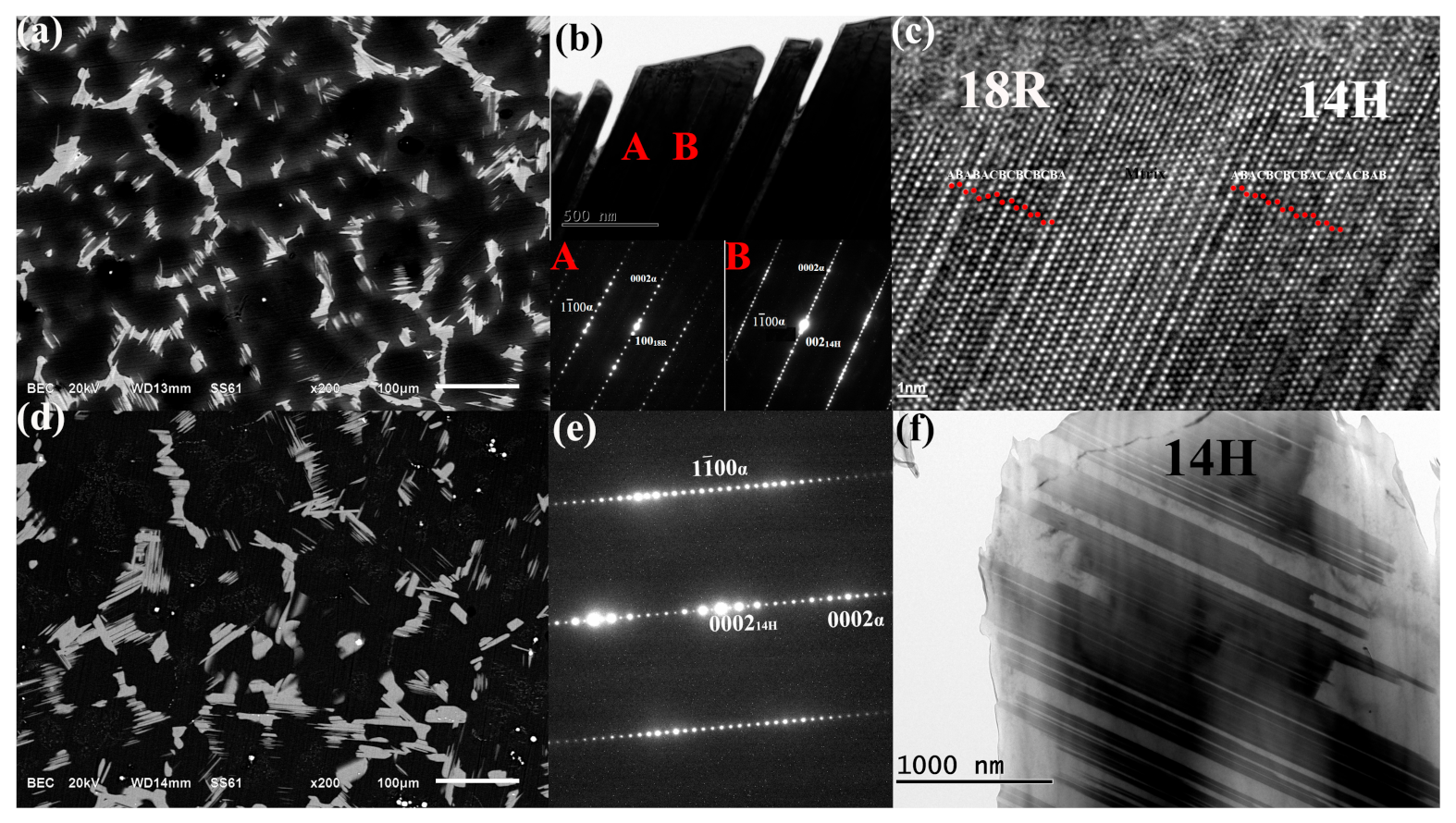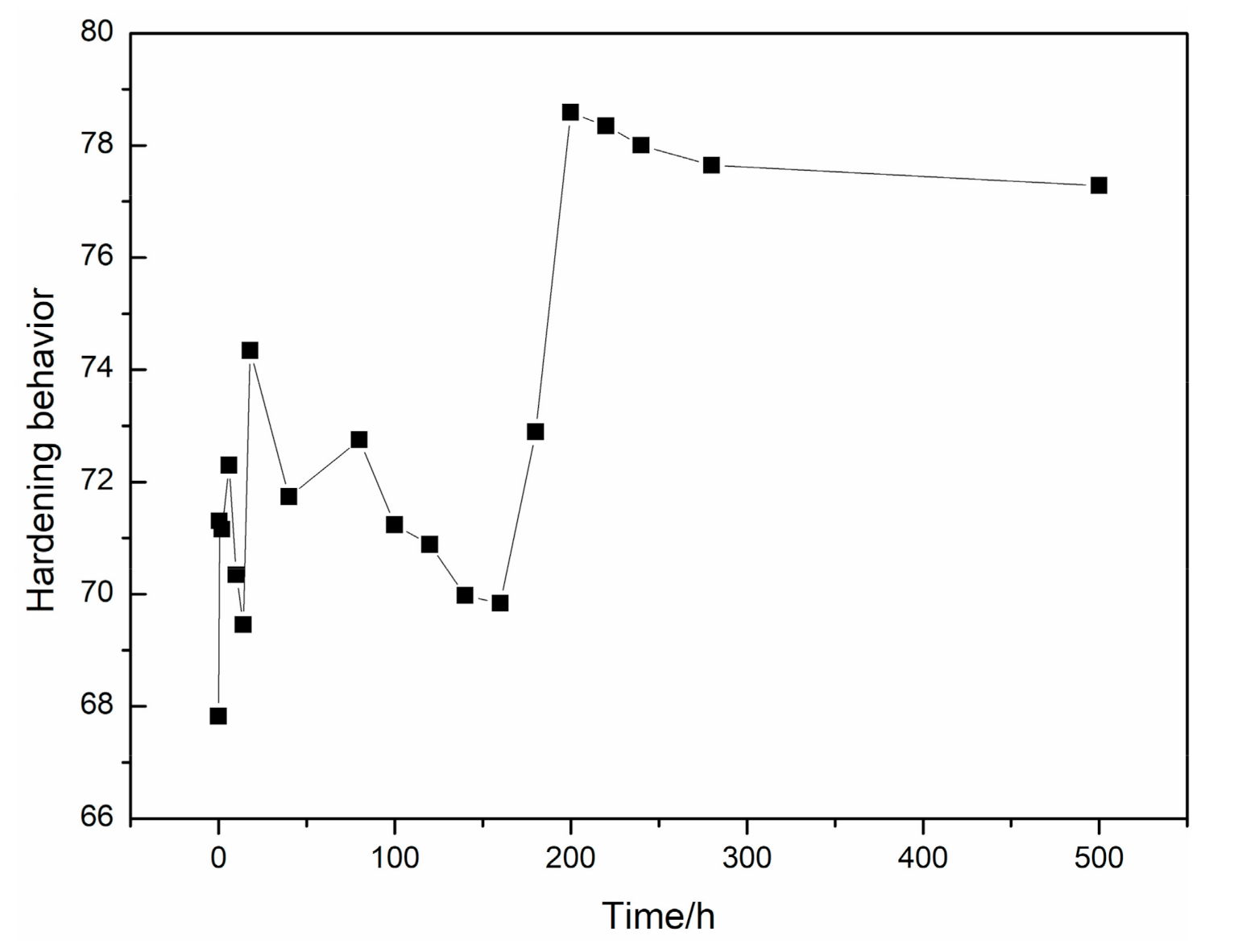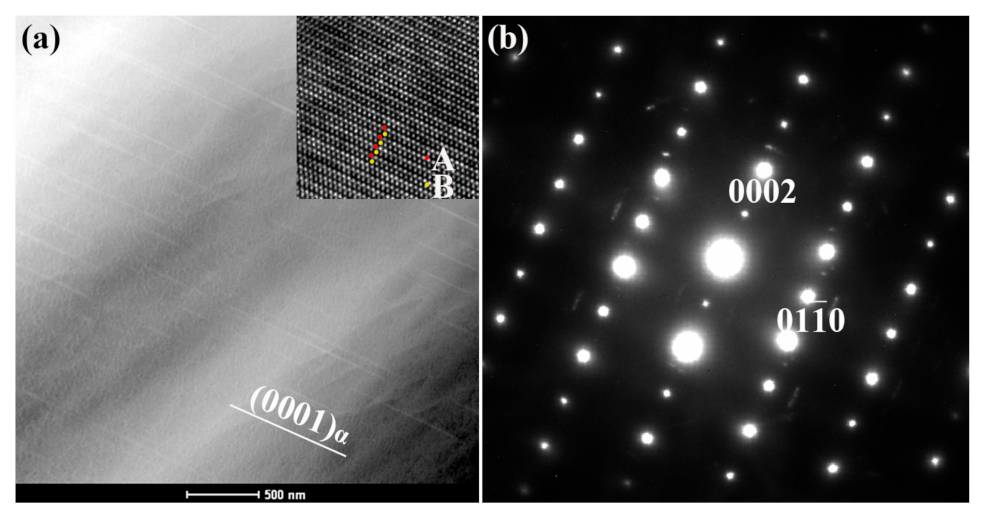Precipitation Behavior of Mg-7Gd-3Y-2Zn-0.5Zr Alloy during Isothermal Aging
Abstract
:1. Introduction
2. Materials and Methods
3. Results
3.1. As-Cast and As-Homogenized Microstructures
3.2. Age Hardening Behavior
3.3. As-Aged Microstructures
3.3.1. Under-Aged Microstructures: Precipitates
3.3.2. Peak-Aged Microstructures: +β′/β1 Precipitates
3.3.3. Over-Aged Microstructures: γ′ + LPSO(14H/18R) + β′/β1 Precipitates
4. Discussion
5. Conclusions
- The as-cast microstructure of the present alloy was mainly composed of α-Mg, 14H-LPSO, and 18R-LPSO structures. Unlike in our previous Nd-containing alloy, (Mg, RE)3Zn eutectic was not found, which indicates that Nd can suppress the formation of (Mg, Zn)3RE and impede the formation of LPSO phases, especially 18R-type, during solidification.
- The two types of precipitation sequence that involve Mg–Gd and LPSO type were found during aging. The LPSO type sequence consists of the precipitation of γ′′, γ′, and 14H-LPSO/18R-LPSO. The Mg–Gd-type precipitation sequence involves the formation of β′(b.c.o.) and β1(f.c.c.). The precipitation of the LPSO type occurred prior to that of the Mg–Gd type in the present alloy. The priority precipitation of the Mg–Gd and LPSO type sequences was affected by Nd, which has higher diffusion coefficient than Gd and Y.
- The coprecipitation of basal γ′ and non-basal β′/β1 served as the key strengthening phases at the peak-aged stage. These two types of phases joined to construct a 3D network to strengthen the matrix.
- The dislocation structure observation suggested that c+a dislocations developed only in the peak-aged alloy. The activity of c+a dislocations after aging indicated that the CRSS of non-basal slip may have been decreased by the formation of LPSO phase.
Author Contributions
Funding
Institutional Review Board Statement
Informed Consent Statement
Data Availability Statement
Conflicts of Interest
References
- Friedrich, H.E.; Mordike, B.L. Magnesium Technology; Springer: Berlin, Germany, 2006; pp. 20–24. [Google Scholar]
- Nie, J.F. Physical Metallurgy of Light Alloys. In Physical Metallurgy, 5th ed.; Elsevier: Amsterdam, The Netherlands, 2014; pp. 2009–2156. [Google Scholar]
- Nie, J.F. Precipitation and Hardening in Magnesium Alloys. Metall. Mater. Trans. A 2012, 43, 3891–3939. [Google Scholar] [CrossRef] [Green Version]
- Lorimer, G.W.; Apps, P.J.; Karimzadeh, H.; Nie, J.F. Improving the performance of Mg-rare alloys by the use of Gd or Dy additions. Mater. Sci. Forum 2003, 419, 279–284. [Google Scholar] [CrossRef]
- Smola, B.; Stulikova, I.; Vonbuch, F.; Mordlike, B.L. Structural aspects of high performance Mg alloys design. Mater. Sci. Eng. A 2002, 324, 113–117. [Google Scholar] [CrossRef]
- Aghion, E.; Bronfin, B.; Eliezer, D. The role of the magnesium industry in protecting the environment. J. Mater. Process. Technol. 2001, 117, 381–385. [Google Scholar] [CrossRef]
- Gao, L.; Chen, R.S.; Han, E.H. Effects of rare-earth elements Gd and Y on the solid solution strengthening of Mg alloys. J. Alloys Compd. 2009, 481, 379–384. [Google Scholar] [CrossRef]
- Liang, S.; Guan, D.; Tan, X.; Chen, L.; Tang, Y. Effect of isothermal aging on the microstructure and properties of as-cast Mg–Gd–Y–Zr alloy. Mater. Sci. Eng. A 2011, 528, 1589–1595. [Google Scholar] [CrossRef]
- Xu, L.; Liu, C.-M.; Wan, Y.-C.; Wang, X.; Xiao, H.-C. Effects of heat treatments on microstructures and mechanical properties of Mg−4Y−2.5Nd−0.7Zr alloy. Mater. Sci. Eng. A 2012, 558, 1–6. [Google Scholar] [CrossRef]
- Peng, Q.; Hou, X.; Wang, L.; Wu, Y.; Cao, Z.; Wang, L. Microstructure and mechanical properties of high performance Mg–Gd based alloys. Mater. Des. 2009, 30, 292–296. [Google Scholar] [CrossRef]
- He, S.M.; Zeng, X.Q.; Peng, L.M.; Gao, X.; Nie, J.F.; Ding, W.J. Precipitation in a Mg–10Gd–3Y–0.4Zr (wt.%) alloy during isothermal ageing at 250 °C. J. Alloys Compd. 2006, 421, 309–313. [Google Scholar] [CrossRef]
- Apps, P.J.; Karimzadeh, H.; King, J.F.; Lorimer, G.W. Precipitation reactions in Magnesium-rare earth alloys containing Yttrium, Gadolinium or Dysprosium. Scr. Mater. 2003, 48, 1023–1028. [Google Scholar] [CrossRef]
- Chen, P.; Li, D.-L.; Yi, J.-X.; Wen, L.; Tang, B.-Y.; Peng, L.-M.; Ding, W.-J. Structural, elastic and electronic properties of b0 phase precipitate in Mg–Gd alloy system investigated via first-principles calculation. Solid State Sci. 2009, 11, 2156–2161. [Google Scholar] [CrossRef]
- Li, T.; Du, Z.; Zhang, K.; Li, X.; Yuan, J.; Li, Y.; Ma, M.; Shi, G.; Fu, X.; Han, X. Characterization of precipitates in a Mg-7Gd-5Y-1Nd-0.5Zr alloy aged to peak-ageing plateau. J. Alloys Compd. 2013, 574, 174–180. [Google Scholar]
- Zhang, X.; Meng, L.; Fang, C.; Peng, P.; Ja, F.; Hao, H. Effect of Nd on the microstructure and mechanical properties of Mg–8Gd–5Y–2Zn–0.5Zr alloy. Mater. Sci. Eng. A 2013, 586, 19–24. [Google Scholar] [CrossRef]
- Li, M.; Zhang, K.; Li, X.; Li, Y.; Ma, M.; Shi, G.; Yuan, J.; Li, T.; Liu, J. The research of microstructure and mechanical properties of Mg-7Gd-3Y-1Nd-0.5Zn-0.5Zr (wt.%) alloy. Mater. Sci. Eng. A 2015, 626, 415–422. [Google Scholar] [CrossRef]
- Yuan, J.; Li, T.; Zhang, K.; Li, M.; Li, X.; Li, Y.; Ma, M.; Shi, G. Effect of Zn content on the microstructures, mechanical properties, and damping capacities of Mg-7Gd-3Y-1Nd-0.5Zr based alloys. J. Alloys Compd. 2019, 773, 919–926. [Google Scholar] [CrossRef]
- Homma, T.; Kunito, N.; Kamado, S. Fabrication of extraordinary high-strength magnesium alloy by hot extrusion. Scr. Mater. 2009, 61, 644–647. [Google Scholar] [CrossRef]
- Rong, W.; Wu, Y.; Zhang, Y.; Sun, M.; Chen, J.; Peng, L.; Ding, W. Characterization and strengthening effects of γ′ precipitates in a high-strength casting Mg-15Gd-1Zn-0.4Zr (wt.%) alloy. Mater. Charact. 2017, 126, 1–9. [Google Scholar] [CrossRef]
- Li, Z.; Zheng, J.; Chen, B. Unravelling the Structure of γ″ in Mg-Gd-Zn: An Atomic-scale HAADF-STEM Investigation. Mater. Charact. 2016, 120, 345–348. [Google Scholar] [CrossRef]
- Nie, J.F.; Oh-ishi, K.; Gao, X.; Hono, K. Solute segregation and precipitation in a creep-resistant Mg–Gd–Zn alloy. Acta Mater. 2008, 56, 6061–6076. [Google Scholar] [CrossRef]
- Nie, J.F.; Gao, X.; Zhu, S.M. Enhanced age hardening response and creep resistance of Mg–Gd alloys containing Zn. Scr. Mater. 2005, 53, 1049–1053. [Google Scholar] [CrossRef]
- Han, X.Z.; Xu, W.C.; Shan, D.B. Effect of precipitates on microstructures and properties of forged Mg–10Gd–2Y–0.5Zn–0.3Zr alloy during ageing process. J. Alloys Compd. 2011, 509, 8625–8631. [Google Scholar] [CrossRef]
- Kawamura, Y.; Yamasaki, M. Formation and Mechanical Properties of Mg97Zn1RE2 Alloys with Long-Period Stacking Ordered Structure. Mater. Trans. 2007, 48, 2986–2992. [Google Scholar] [CrossRef] [Green Version]
- Xu, C.; Zheng, M.Y.; Wu, K.; Fan, G.H.; Xu, S.W.; Kamado, S.; Liu, X.D.; Wang, G.J.; Lv, X.Y. Effect of ageing treatment on the precipitation behaviour of Mg–Gd–Y–Zn–Zr alloy. J. Alloys Compd. 2013, 550, 50–56. [Google Scholar] [CrossRef]
- Li, T.; Chen, D.J.; Liu, W.; Yuan, J.W.; Qu, J. Effect of Zn on microstructure evolution of Mg-Gd-Y-Nd-Zn- Zr alloy during heat treatment. IOP Conf. Ser. Mater. Sci. Eng. 2019, 542, 233–239. [Google Scholar] [CrossRef]
- Zheng, J.K.; Zhu, C.; Li, Z.; Luo, R.; Zeng, X.; Chen, B. On the strengthening precipitate structures in Mg-Gd-Ag alloy: An atomic-resolution investigation using Cs-corrected STEM. Mater. Lett. 2019, 238, 66–69. [Google Scholar] [CrossRef]
- Liu, W.; Du, Z.-W.; Li, T.; Zhang, K.; Han, X.-L.; Peng, Y.-G.; Zhang, J.; Yuan, J.-W.; Liu, S.-F.; Pang, Z. Precipitate evolution in Mg−7Gd−3Y−1Nd−1Zn−0.5Zr alloy during isothermal ageing at 240 °C. Trans. Nonferrous Met. Soc. China 2019, 29, 2047–2055. [Google Scholar] [CrossRef]
- Paliwal, M.; Das, S.K.; Kim, J.; Jung, I.H. Diffusion of Nd in hcp Mg and interdiffusion coefficients in Mg–Nd system. Scr. Mater. 2015, 108, 11–14. [Google Scholar] [CrossRef]
- Matsuda, M.; Ando, S.; Nishida, M. Dislocation Structure in Rapidly Solidified Mg97Zn1Y2 Alloy with Long Period Stacking Order Phase. Mater. Trans. 2005, 46, 361–364. [Google Scholar] [CrossRef] [Green Version]






Publisher’s Note: MDPI stays neutral with regard to jurisdictional claims in published maps and institutional affiliations. |
© 2021 by the authors. Licensee MDPI, Basel, Switzerland. This article is an open access article distributed under the terms and conditions of the Creative Commons Attribution (CC BY) license (https://creativecommons.org/licenses/by/4.0/).
Share and Cite
Yuan, J.; Li, T.; Zhang, K.; Li, X.; Li, Y.; Ma, M.; Shi, G.; Du, Z.; Liu, W.; Peng, Y. Precipitation Behavior of Mg-7Gd-3Y-2Zn-0.5Zr Alloy during Isothermal Aging. Materials 2021, 14, 1737. https://doi.org/10.3390/ma14071737
Yuan J, Li T, Zhang K, Li X, Li Y, Ma M, Shi G, Du Z, Liu W, Peng Y. Precipitation Behavior of Mg-7Gd-3Y-2Zn-0.5Zr Alloy during Isothermal Aging. Materials. 2021; 14(7):1737. https://doi.org/10.3390/ma14071737
Chicago/Turabian StyleYuan, Jiawei, Ting Li, Kui Zhang, Xinggang Li, Yongjun Li, Minglong Ma, Guoliang Shi, Zhiwei Du, Wei Liu, and Yonggang Peng. 2021. "Precipitation Behavior of Mg-7Gd-3Y-2Zn-0.5Zr Alloy during Isothermal Aging" Materials 14, no. 7: 1737. https://doi.org/10.3390/ma14071737
APA StyleYuan, J., Li, T., Zhang, K., Li, X., Li, Y., Ma, M., Shi, G., Du, Z., Liu, W., & Peng, Y. (2021). Precipitation Behavior of Mg-7Gd-3Y-2Zn-0.5Zr Alloy during Isothermal Aging. Materials, 14(7), 1737. https://doi.org/10.3390/ma14071737




